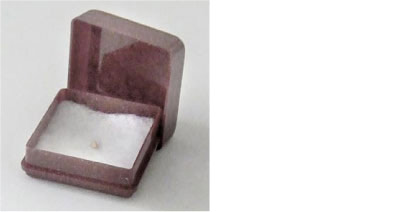2009
Installation of 7 identical jewelry boxes each containing one grain of sand from the Judean Desert. Each grain of sand displays a certain hypostasis of existence (sacral, profane, historical, scientific, philosophical, poetic and scholar), and is provided with a short commentary. The installation takes place in a big plain hall, thus creating the contrast between big and small.

Grain of Sand Maria from Judean Desert (from the Dead Sea Coast)
The Sacral One
The promise received by Abraham from God, says: “I will bless you greatly, and increase your offspring like the stars of the sky and the sand on the seashore.” (Bereshit / Genesis 22:17).
To be “incalculable” is not only a quantitative category, but also qualitative one. It is impossible to count non-similar objects. When naming an object, we give it individuality, thus distinguishing it from the others, therefore outlining it.

Grain of Sand No. 324 from Judean Desert
The Profane One
Calculating is counting, division and addition based on the similar quality, a finding of a total sum, a result. On the other hand, calculation does bear in itself a destruction of an integration. Number allocated to the object, makes it alike to the others, deprives it from the signs of individuality, and places on the same level as all the other objects counted before it and yet to be counted. Number 324 is a quadrate of number 18, which is the Cabbalistic number of life.

Grain of Sand named after Archimedes from Judean Desert
The Historical One
In the essay, written in the 3rd century BC, known under the name of "Calculation of the Grains of Sand" ("Psammit"), Archimedes states an innovative system of representing multiplicities. He needed this system to calculate the number of grains of sand to fill in the Universe.

Grain of Sand SiO2 from Judean Desert
The Scientific One
Oxide silicon (SiO2) is the chemical formula of quartz which we know as sand. Quartz is the most widespread mineral on the Earth.
Approximately 12 % of the Earth crust consists of sand. The biggest part of the sand in the beaches and oceans, as well as granite (silicon cliffs) consist of the smallest quartz grains of sand.

Grain of Sand-Universe from Judean Desert
The Philosophical One
Li Hongzhi (Li Hongzhi, “Zhuan Falun”, The Universe Publishing Company, 2000) refers to the statement of Buddha Sakiamuni that says: "On the microscopic level, one grain of sand contains three thousands of worlds".
It is similar to the Universe that is full of life. Is there sand in the Universe which is inside of this grain of sand? Are there three thousand worlds in each grain of sand of all sand which is inside of that initial grain of sand? Sakiamuni made the following statement: "The Universe is so immense that it is impossible to reach its limits, and at the same time it is so fine that it is as impossible to reach its smallest component".

Grain of Sand without the Name from Judean Desert
The Poetic One
"You are only a grain of sand in the desert".
Joseph Brodsky
"To see a World in a Grain of Sand
And a Heaven in a Wild Flower,
Hold Infinity in the palm of your hand
And Eternity in an hour".
From “Auguries of Innocence” by William Blake

Volume Grain of Sand from Judean Desert
The Scholar One
“... As one of the ways to calculate the number of grains of sand in the desert, I suggest comparing their volumes.
In order to do so, we need to know the area and the depth of the sand level in the desert, and the volume of one grain of sand. Then the number of grains of sand = area*depth/volume of one grain of sand. For example, the desert area is 4800 sq.km. We can admit that depth of sand is 2 м, and volume of a grain of sand is 2 cubic mm.
Thus, the quantity of grains of sand = (4800 sq.km*2 м):2 sq.mm.
Now it is necessary to translate all data in one unit of measure (most conveniently in meters) and to make the calculations.”
From the work by Dmitry Miroshnikov, a pupil of the 5A grade of the Novosibirsk Lyceum of IT, at the 8th Russian Heuristic Competition in Mathemtics.